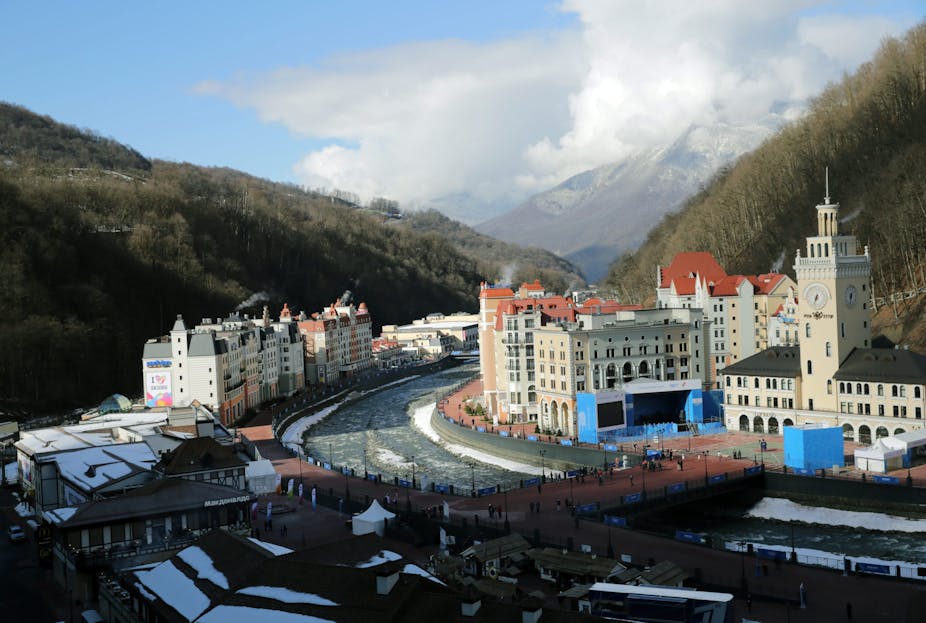Sochi – currently hosting the Winter Olympics – looks like the beach resort it is, situated on the blue waters of the east coast of the Black Sea, and enjoying a sub-tropical climate. There is what looks like a palm-tree on its coat-of-arms and flag.
It’s not surprising that Josef Stalin built a dacha in this, his favourite place to relax, studding it with buildings in a neo-classical style – several of which were sanatoriums – and making it both famous and fashionable in Soviet Russia. But he did not create its reputation: the shores of the Black Sea were traditionally the mecca for old-regime Russians as well as state-sponsored citizens of the USSR keen to play in the sun.
Yet sea-bathing is obviously not Sochi’s only attraction. Fifty kilometres inland, the terrain starts to soar. The town of Krasnaya Polyana (“red” or “beautiful glade”), the centre of the Winter Olympics, nestles among snow-clad mountains, the Caucasus, that form a stunning backdrop.
This is where 19th-century Russia engaged in its self-appointed task of subduing the local, mostly Muslim tribes, and where some of the most brilliant Russian writers found creative inspiration. At some point during their lives Alexander Pushkin, Mikhail Lermontov and Lev Tolstoy all came to the Caucasus, for varying reasons.
Pushkin’s Caucasus
In 1820, at the age of 21, Pushkin was in serious trouble for writing radical poetry (“I will sing of Liberty/ And scourge the evil that sits on thrones …”).

Luckily he got off lightly, dispatched to the offices of the Administrator of the Southern Colonies, and thence permitted to accompany the family of a schoolfriend to one of the numerous mineral springs. The hot, sulphuric waters did him “no end of good”, he wrote to his brother, “gushing, steaming and pouring over the mountainside in all directions …”
But his poetic nature was also enthralled by the scenery:
this magnificent mountain range with its summits of ice, looking like strange, motionless, multi-coloured clouds far, far away in the glowing dawn.
Never did he forget this place, enshrining the “growling streams, thundering white avalanches, shrieking eagles and singing girls” in his Prisoner of the Caucasus, a narrative poem about a young Russian captured by Chechens and in love with a daughter of the enemy. Their ultimate incompatibility becomes a metaphor for the philosophical gulf between civilisation and wild nature.
Lermontov in exile

Pushkin’s contemporary, Lermontov, was also as a young army officer exiled to the region because of his anti-authoritarian verses – specifically a poem ascribing the death of Pushkin to official persecution. But Lermontov is best known to English readers for his postmodern novel, A Hero of Our Time, a group of five stories with three interrelated narrators, set in the Caucasus in 1837. As Vladimir Nabokov wrote in his Foreword:
The five stories grow, revolve, reveal, and mask their contours, turn away and reappear in a new attitude or light like five mountain peaks attending a traveller along the meanders of a Caucasian canyon road.
The longest story, Princess Mary, takes place a little way down from the awesome peaks, at a spa – a watering-place typical of the region and favourable to the dangerous delights of dalliance.
Spa-towns, like Bali beaches today, allowed people to adopt holiday mode:
The wives of the local officials, the hostesses of the waters … are very charming, and remain charming for a long time! Every year their admirers are replaced by new ones …
However, the light touch turns cruel in this brilliant account of manipulation and seduction inflicted on Mary by the officer Pechorin, who shoots her would-be lover in a duel. The tragic followup was Lermontov’s own death in a similar manner, at the age of 24.
Tolstoy in the south
The towering Caucasus spawned not only Pushkin’s poem, plus the Russian composer Cui’s operatic version of it, but a novella also titled A Prisoner in the Caucasus authored in 1872 by Tolstoy, which itself engendered two Russian films (in 1967 and 1996). Yet among Tolstoy’s huge output, the greatest work of Caucasian inspiration must surely be his short novel The Cossacks.

In 1863, Tolstoy had decided to avoid paying the considerable gambling debts he’d acquired in Moscow by accompanying his officer-brother back to an outpost where the Russian army was attempting to subdue the local tribes.
The autobiographical hero of The Cossacks, Dmitri Olenin, envisages himself sloughing off the trammels of civilisation, living like a native, and acquiring “authenticity”; en route he dreams, equally fantastically, of “Circassian women, mountains, precipes, fearful torrents and danger”.
Suddenly his eyes meet “about twenty paces away, gigantic pure white masses with gentle curves and fantastical airy summits minutely outlined against the distant sky …”. Incredulously he asks the driver what they are. “Just the mountains,” comes the laconic answer.
In that gulf between romantic idealism and down-to-earth practicality lies the lesson that Tolstoy’s hero must learn. Hopefully our winter athletes already have.

